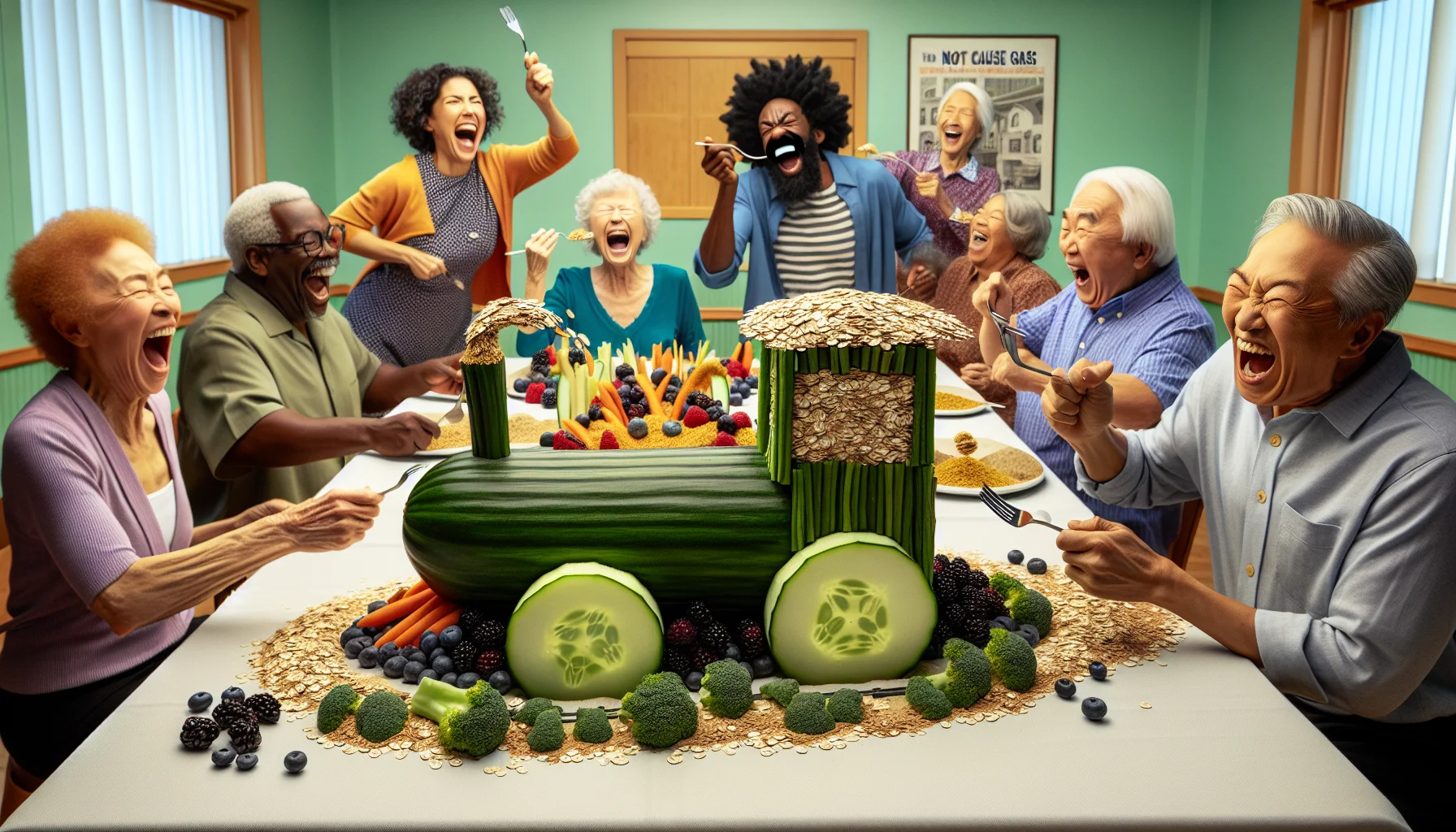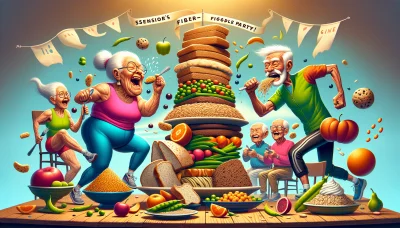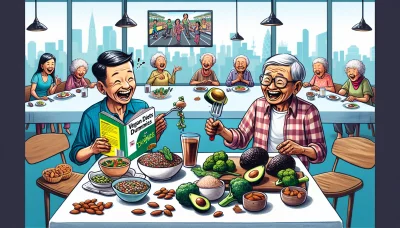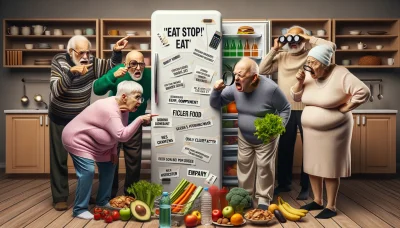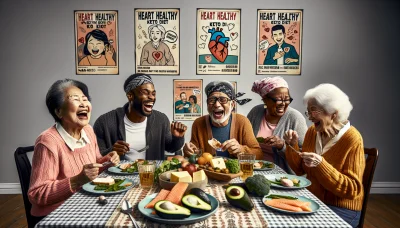High fiber foods that don't cause gas Quiz
Test Your Knowledge
Question of
Understanding High Fiber Diets
Benefits of High Fiber Intake
A high fiber diet is like a tune-up for your digestive system; it keeps things running smoothly. Fiber-rich foods, such as fruits, vegetables, legumes, and whole grains, are stellar at keeping you regular. They act like nature's broom, sweeping your intestines clean and cutting the risk of constipation.
But that's not all! Fiber is a superhero when it comes to your health. It can help lower cholesterol levels, control blood sugar, and even assist in achieving a healthy weight. Foods with fiber often require more chewing, meaning you'll likely eat slower and feel full longer. Plus, they're typically lower in calories yet highly satisfying.
Boosting Digestive Health
Diving into the world of digestive health, fiber stands out as a key player. It absorbs water and adds bulk to your stool, making it softer and easier to pass. This can dramatically reduce the chances of developing hemorrhoids or small pouches in your colon, known as diverticular disease.
Fiber's benefits extend beyond just the mechanics of digestion. It also nourishes your gut bacteria those tiny but mighty organisms that play a huge role in your overall health. A fiber-rich diet helps maintain a balanced microbiome which is crucial for digestion and immune function.
Reducing the Risk of Chronic Diseases
When it comes to fighting chronic diseases, fiber packs a powerful punch. Studies show that a diet high in fiber can significantly reduce the risk of heart disease and type 2 diabetes. The secret lies in its ability to lower bad cholesterol and regulate blood sugar levels.
Moreover, fiber may have protective effects against certain cancers like colon cancer. By speeding up the elimination of waste from your body and minimizing the time harmful substances stay in contact with colon cells, fiber helps keep your colon healthy.
Common Misconceptions About Fiber
Fiber often gets a bad rap due to some common misconceptions floating around out there. One myth is that all fiber is created equal when in reality there are two types: soluble and insoluble each with its unique benefits. Soluble fiber dissolves in water and can help lower glucose levels, while insoluble fiber does not dissolve in water and helps food move through your digestive system more quickly.
Another widespread belief is that only older adults need to worry about getting enough fiber. The truth is everyone needs fiber throughout their lives for optimal health. It's essential for maintaining regular bowel movements, preventing constipation, and reducing the risk of various diseases regardless of age.
Fiber and Bloating: Separating Fact from Fiction
Bloating can happen when adding too much fiber too quickly to the diet or not drinking enough water with high-fiber foods. Your body needs time to adjust to increased fiber intake; otherwise, you might experience discomfort or bloating.
To minimize these effects, ramp up your fiber intake gradually over several weeks. This allows your digestive system to adapt without going into shock mode. Also ensure you're staying hydrated by drinking plenty of fluids throughout the day.
The Truth About Fiber and Gas Production
- Increase Slowly: To avoid excess gas when starting a high-fiber diet, increase your intake slowly over time.
- Hydration is Key: Drink plenty of water as you increase your fiber intake; this helps move fiber through the digestive system more smoothly.
- Mix Up Your Sources: Get your fiber from various sources such as vegetables, fruits, whole grains, and legumes to balance nutrient intake.
- Cook Your Veggies: Cooking vegetables can break down some of the fibers that cause gas production.
- Mindful Eating: Eat slowly and chew thoroughly to reduce swallowing air which can contribute to gas buildup.
- Fermentable Fibers: Be aware that some fibers are fermentable which means they may naturally produce more gas during digestion.
- Probiotics Might Help: Introducing probiotics into your diet can improve gut health which may help manage gas production related to increased fiber intake.
- Exercise Regularly: Regular physical activity helps stimulate digestion and reduces gas buildup.
- If Problems Persist: If excess gas continues despite gradual increases in dietary fiber or changes in eating habits consult a healthcare professional for advice.
Identifying Low-Gas Fiber Sources
Soluble vs. Insoluble Fiber
Understanding the difference between soluble and insoluble fiber is crucial for managing digestive health. Soluble fiber dissolves in water, forming a gel-like substance that slows digestion and can help lower cholesterol. Insoluble fiber, on the other hand, does not dissolve in water and adds bulk to stool, which aids in its passage through the digestive system.
People with sensitive stomachs may prefer soluble fibers as they are less likely to cause gas. However, a balance of both types of fiber is important for overall gut health. Knowing which foods contain each type of fiber can assist in creating a diet that minimizes discomfort while maximizing health benefits.
Foods Rich in Soluble Fiber
Foods rich in soluble fiber include oats, legumes, apples, and blueberries. These foods can be easier on the digestive system, reducing the likelihood of gas production. Including these items in your diet can help you meet your daily fiber needs without causing undue stress on your gut.
Incorporating these foods into meals is simple and effective. For instance, starting your day with oatmeal topped with blueberries or adding beans to a salad can significantly increase your soluble fiber intake while keeping your digestive system happy.
Foods High in Insoluble Fiber
Foods high in insoluble fiber include whole grains, nuts, potatoes, and green leafy vegetables. These are essential for maintaining regular bowel movements. While they may cause more gas for some individuals, they are still an important part of a balanced diet.
To minimize potential discomfort from insoluble fibers, introduce them gradually into your diet and pair them with plenty of water intake. This gradual introduction helps your digestive system adjust without causing significant gas or bloating.
Optimal Fiber Foods for Sensitive Stomachs
For those with sensitive stomachs, choosing high-fiber foods that are less likely to produce gas is key to maintaining both comfort and nutritional balance. There are certain fruits and vegetables known for their gentle effect on the gut while providing the necessary dietary fiber.
It's essential to listen to your body's response to different foods and adjust accordingly. Keeping a food diary may help identify which high-fiber foods align best with your digestive health needs.
Vegetables That Are Gentle on the Gut
Certain vegetables like zucchini, tomatoes, and bell peppers are known for their gentle nature on the digestive system. These veggies provide necessary nutrients without contributing significantly to gas production.
- Zucchini: High in water content and easy to digest when cooked.
- Tomatoes: Versatile and low in insoluble fibers that typically cause gas.
- Bell peppers: Packed with vitamins and low in fermentable carbohydrates.
Fruits That Minimize Gas
Citrus fruits like oranges and grapefruits offer high amounts of fiber with lower risk of causing gas. Additionally, bananas and strawberries can be good choices for those looking to maintain a healthy gut without discomfort.
Eating these fruits fresh rather than dried or canned can further reduce the risk of gas since dried fruits often have higher concentrations of sugars that can ferment in the gut. By choosing these low-gas options, individuals with sensitive stomachs can enjoy the benefits of fruit without fear of discomfort.
Integrating Fiber into Your Diet Without Discomfort
Gradual Increase of Fiber Intake
Starting with a surge of fiber can shock your system, so it's essential to begin slowly. Incremental increases allow your digestive system to adapt without significant discomfort. Start with adding one high-fiber food to your diet and then gradually add more over several weeks.
Monitoring your body's response to increased fiber is crucial. If you experience minimal gas or bloating, that's a positive sign! It suggests that your digestive system is adapting well. However, if discomfort arises, take a step back and adjust your fiber intake more gradually.
Daily Fiber Goals: How to Ramp Up Slowly
Your daily fiber goals are within reach if you plan carefully. Aiming for an additional 5 grams per week until you meet the recommended 25-30 grams per day for adults can be a practical approach. This way, you're not overwhelming your system while working towards your target.
Signs Your Body is Adjusting Well to More Fiber
Positive signs include regular bowel movements and a decrease in constipation episodes. You might also notice a reduction in hunger pangs as fiber contributes to satiety. These indicators suggest that your gradual fiber integration is successful.
Combining Foods for Better Digestion
The secret to adding fiber without the pain? Smart food combinations! Pairing high-fiber foods with foods that aid digestion can minimize potential discomfort like bloating and gas. For instance, combine beans with rice or include a source of protein with your leafy greens.
Remember, timing is everything when it comes to meal planning with high-fiber foods. Spacing out fiber-rich meals throughout the day gives your body time to process them more efficiently. Avoid consuming large amounts of fiber all at once to keep digestive issues at bay.
Food Pairings That Reduce Gas
- Eat Fruits Alone: Some fruits ferment quickly in the stomach, so eating them alone reduces gas production.
- Pair Grains with Greens: Combining grains like brown rice with greens helps ease digestion and reduce bloating.
- Mix Legumes with Herbs: Adding herbs such as ginger or fennel when cooking legumes can help mitigate gassiness.
- Dairy Alternatives: For those sensitive to lactose, pairing whole grains with dairy alternatives can help maintain high dietary fiber without discomfort.
- Hydrate Adequately: Drinking plenty of water aids in breaking down soluble fiber, thereby easing its passage through the digestive tract.
Timing Your Meals to Avoid Discomfort
Scheduling high-fiber meals evenly throughout the day allows for better absorption and less distress. Eating a high-fiber breakfast followed by moderate amounts in lunch and dinner contributes to smoother digestion. Also, ensure you're drinking enough fluids throughout the day!
Preparing High Fiber Meals
Cooking Techniques for Gas Reduction
Introducing high-fiber foods to your diet can lead to gas and discomfort, but fear not! Proper cooking techniques can significantly alleviate these symptoms. The key is in the preparation. Soaking beans and legumes overnight before cooking them can help remove some of the indigestible sugars that cause gas. This simple step is a game-changer for a comfortable dietary transition.
Once soaked, don't skip on rinsing! Thoroughly washing your beans and grains after soaking them further ensures the removal of those pesky sugars. It's not just about soaking; it's about washing away what's been drawn out from the soak. Think of it as a two-step process for your digestive peace!
The Importance of Soaking and Rinsing cannot be overstated when it comes to high-fiber ingredients. By doing so, you're setting yourself up for success in reducing gas production. It's not just about the time you soak, but also the quality of water used. Fresh, clean water makes all the difference in this preparatory stage.
Now, let's spice things up! Using Herbs and Spices to Aid Digestion is your secret weapon. Ingredients like ginger, turmeric, and fennel aren't just flavor enhancers; they're digestive aids that can help mitigate gas production. Incorporating these into your meals not only boosts taste but also supports your gut health.
Recipe Ideas for a Low-Gas Diet
Mornings are critical when following a high-fiber, low-gas diet. Starting off with a balanced breakfast sets the tone for your day. Opt for oatmeal topped with berries or try incorporating chia seeds into smoothies. These options pack a fiber punch without weighing you down with gas troubles.
- Breakfast Options to Start Your Day Right: Keep it light yet satisfying with poached eggs on whole-grain toast or a quinoa breakfast bowl adorned with nuts and fruit.
- Dinner Dishes That Won't Leave You Bloated: Embrace grilled chicken with steamed vegetables or baked salmon with a side of seasoned lentils. These dishes are hearty, nutritious, and kind to your digestive system.
Dinner doesn't have to be daunting on a high-fiber diet. There are countless recipes that are both filling and gentle on the stomach. A stir-fry featuring tofu and an array of colorful veggies served over brown rice is both satisfying and low-gas inducing. Another great option is roasted vegetables with quinoa; it's a flavorful dish that won't leave you regretting your meal choice.
The versatility of high-fiber ingredients allows for creative culinary exploration without the fear of bloating or discomfort post-meal. With these recipe ideas in your arsenal, you can enjoy delicious dinners that cater to both taste buds and tummy comfort!
Managing Fiber Intake with Special Diets
High Fiber Options for Gluten-Free Eating
Embarking on a gluten-free journey doesn't mean compromising on fiber! There are countless high-fiber foods that naturally lack gluten and can seamlessly fit into your diet. From fruits and vegetables to seeds and certain grains, the variety is both surprising and satisfying. It's all about knowing where to look and making those smart choices that keep your digestive system happy while sticking to the gluten-free rulebook.
The key is in diversifying your sources of fiber. Don't just stick to one type of food; explore the spectrum of gluten-free options available. Incorporate a mix of raw and cooked vegetables, throw in some berries for a sweet treat, and don't forget those powerhouse seeds like chia and flaxseed that can be sprinkled onto almost anything. Variety is not only the spice of life but the secret to a fiber-rich gluten-free diet!
Gluten-Free Grains That Are Easy on the Gut
When it comes to gluten-free grains, quinoa stands out as a superstar. Not only is it packed with fiber, but it's also a complete protein, making it an excellent choice for anyone looking to boost their nutritional intake. Brown rice is another gentle giant in the world of gluten-free grains, offering versatility along with its dietary fiber content. And let's not overlook buckwheat despite its name, it's entirely gluten-free and brimming with nutrients.
Millet and sorghum are two more grains that deserve a spot in your pantry. They're easy to digest, won't trigger any gluten sensitivities, and are perfect for adding substance to meals. Use them in place of traditional grains like wheat or barley, and watch how they transform your dishes into gut-friendly delights without sacrificing texture or taste.
Navigating Legumes and Nuts on a Gluten-Free Diet
Legumes are a treasure trove of fiber, but they can sometimes be cross-contaminated with gluten during processing. To ensure you're getting all the benefits without any risks, opt for certified gluten-free legumes or buy them whole and unprocessed. Chickpeas, lentils, and beans can be excellent additions to your mealsjust remember to check for that gluten-free label!
Nuts are another fantastic source of fiber for those avoiding gluten. Almonds, walnuts, and pecans are not only nutritious but also incredibly versatilegreat for snacking or as an addition to meals. Just be cautious of flavored nuts or those processed on shared equipment with gluten-containing foods; always read labels carefully to maintain your dietary integrity.
Balancing Fiber on a Plant-Based Diet
On a plant-based diet, fiber is abundant but balancing it is crucial. Too much fiber too quickly can lead to digestive discomfort, so it's essential to increase intake gradually. By incorporating a variety of fruits, vegetables, whole grains, nuts, and seeds throughout the day, you can ensure you're getting enough fiber while also providing your body with other vital nutrients necessary for optimal health.
Maintaining a harmonious balance between soluble and insoluble fiber is key on a vegan diet. Soluble fiber found in oats, apples, and beans helps control blood sugar levels and reduces cholesterol, while insoluble fiber from vegetables and whole grains promotes healthy digestion. Striking this balance supports overall well-being and keeps your digestive system functioning smoothly.
Meeting Your Fiber Needs with Plant Proteins
- Eat varied protein sources: Combine legumes with whole grains or nuts within meals to create complete proteins packed with fiber.
- Incorporate protein-rich veggies: Vegetables like broccoli or Brussels sprouts offer both protein and fiber.
- Snack smartly: Opt for edamame or roasted chickpeas as high-fiber protein snacks.
- Choose whole soy products: Tofu and tempeh are less processed than soy isolates while being rich in both protein and dietary fiber.
- Add seeds: Flaxseeds or pumpkin seeds provide an extra punch of protein along with beneficial fibers.
- Leverage lentils: Lentils are not only high in protein but also one of the best plant-based sources of fiber.
- Sprinkle spirulina: This superfood algae packs in protein along with a dose of fiber.
- Balance intake: Spread out your protein-fiber sources across meals to avoid digestive overload.
The Role of Leafy Greens in a Balanced Vegan Diet
Leafy greens are non-negotiable when curating a balanced vegan diet rich in fiber. Spinach, kale, collard greens these chlorophyll-packed wonders aren't just low in calories; they're high in both soluble and insoluble fibers that aid digestion while keeping you fuller longer. Integrating them into daily meals adds volume without excess calories while ensuring you meet your daily nutrient quotas effortlessly.
Beyond their fibrous benefits, leafy greens bring an array of vitamins like A, C, E, K, as well as minerals such as iron and calcium essential nutrients often lacking in poorly planned vegan diets. They act as nutritional powerhouses that bolster overall health beyond just aiding digestionthey support bone health, enhance immune function, combat inflammationthe list goes on! Embrace these verdant veggies at every meal for ultimate vitality!
Overcoming Challenges with High Fiber Foods
Dealing with Resistant Starches
Tackling the hurdles of resistant starches is a crucial part of mastering your high fiber diet. These starches resist digestion in the small intestine, reaching the colon where they ferment, sometimes causing gas and discomfort. Understanding how to manage them can significantly improve your digestive health.
The key to dealing with resistant starches lies not only in moderation but also in how you prepare your foods. Cooking methods can alter the structure of these starches, reducing their resistance. Gradually increasing your intake allows your body to adapt without causing undue distress.
Identifying Foods High in Resistant Starches
Recognizing which foods are rich in resistant starches empowers you to make informed dietary choices. Common sources include grains, seeds, legumes, and some starchy vegetables like potatoes and green bananas. By identifying these foods, you can better manage their effects on your system.
Not all high-fiber foods are created equal when it comes to resistant starch content. Whole grains like oats and barley have different levels than legumes such as lentils and chickpeas. Paying attention to the types of high-fiber foods you consume can help mitigate potential issues.
Strategies for Incorporating Resistant Starches Without Gas
Incorporating resistant starches into your diet without experiencing gas can be challenging but achievable. Start with smaller portions and increase gradually over time to allow your gut bacteria to adjust. Combining them with other foods can also help dilute their impact.
- Begin Slowly: Introduce resistant starches gradually into your diet to minimize discomfort.
- Mix It Up: Pair resistant starch-rich foods with others to balance out their effects.
- Cook Smart: Experiment with cooking methods that may reduce the resistance of these starches.
- Fermented Options: Consider fermented foods that contain natural probiotics which can aid digestion.
- Mindful Eating: Eat slowly and chew thoroughly to promote better digestion and absorption.
Ensuring Adequate Hydration for Fiber Digestion
Hydration plays a pivotal role in fiber digestion, as water helps fiber pass through the digestive system more easily. This not only aids in regularity but also helps prevent constipation, a common issue when increasing fiber intake without enough fluids.
Increasing your fiber intake demands a corresponding increase in water consumption to maintain balance within the digestive tract. Not staying adequately hydrated can lead to uncomfortable side effects such as bloating and hard stools.
The Connection Between Water and Fiber Absorption
The relationship between water and fiber is synergistic; soluble fiber absorbs water to form a gel-like substance that aids digestion, while insoluble fiber relies on water to add bulk and soften stool. Both types of fiber require sufficient hydration for optimal function.
When there's not enough water available, fiber cannot perform its duties effectively. This can result in gastrointestinal issues that counteract the benefits of a high-fiber diet. Ensuring you drink enough is essential for reaping the full rewards of dietary fiber.
Tips for Drinking Enough Water Throughout the Day
- Create a Schedule: Set reminders or alarms at regular intervals as cues to drink water.
- Carry a Bottle: Keep a reusable water bottle on hand at all times, making it easier to take sips throughout the day.
- Eat Water-Rich Foods: Consume fruits and vegetables with high water content like cucumbers, tomatoes, and melons.
- Morning Ritual: Start your day with a glass of water to kickstart hydration after sleeping.
- Prioritize Hydration: Drink a glass of water before each meal and after every bathroom break.
- Diversify Intake: If plain water doesnt appeal, try flavored or sparkling waters or herbal teas.
